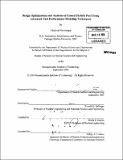Design optimization and analysis of coated particle fuel using advanced fuel performance modeling techniques
Author(s)
Soontrapa, Chaiyod
DownloadFull printable version (7.353Mb)
Alternative title
Coated particle fuel using advanced fuel performance modeling techniques
Other Contributors
Massachusetts Institute of Technology. Dept. of Nuclear Engineering.
Advisor
Ronald G. Ballinger.
Terms of use
Metadata
Show full item recordAbstract
Modifying material properties provides another approach to optimize coated particle fuel used in pebble bed reactors. In this study, the MIT fuel performance model (TIMCOAT) was applied after benchmarking against the experiment results. The optimization study focuses on the fracture toughness of silicon carbide and Bacon anisotropy factor (BAF) of pyrocarbon. The variations on the silicon carbide toughness show that higher fracture toughness leads to a lower fuel failure probability, as expected. However, the results from the BAF variations reveal that a higher BAF lowers a fuel failure probability. This quite contradicts the generally believed notion that a higher BAF would increase fuel failures. In addition to the fuel design optimization, the failure characteristics of coated particle fuel are explained and the key factors influencing such characteristics are identified.
Description
Thesis (S.M.)--Massachusetts Institute of Technology, Dept. of Nuclear Engineering, 2005. Includes bibliographical references (p. 154).
Date issued
2005Department
Massachusetts Institute of Technology. Department of Nuclear Engineering; Massachusetts Institute of Technology. Department of Nuclear Science and EngineeringPublisher
Massachusetts Institute of Technology
Keywords
Nuclear Engineering.